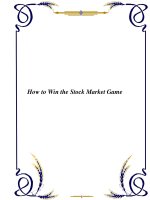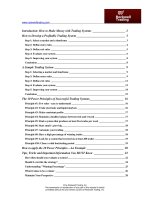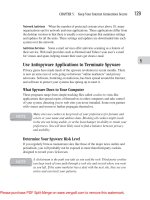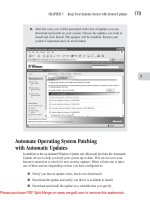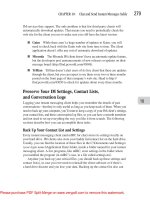Tài liệu How to Make Money with Trading Systems pdf
Bạn đang xem bản rút gọn của tài liệu. Xem và tải ngay bản đầy đủ của tài liệu tại đây (306.09 KB, 28 trang )
www.rockwelltrading.com
© by Rockwell Trading, Inc
Re-transmission or reproduction of any part of this material is strictly
prohibited without the prior written consent of Rockwell Trading, Inc.
Introduction: How to Make Money with Trading Systems ______________________ 2
How to Develop a Profitable Trading System_________________________________ 3
Step 1: Select a market and a timeframe _______________________________________________ 3
Step 2: Define entry rules____________________________________________________________ 4
Step 3: Define exit rules _____________________________________________________________ 5
Step 4: Evaluate your system_________________________________________________________ 6
Step 5: Improving your system _______________________________________________________ 8
Conclusion________________________________________________________________________ 8
A Sample Trading System ________________________________________________ 9
Step 1: Selecting a market and timeframe ______________________________________________ 9
Step 2: Define entry rules____________________________________________________________ 9
Step 3: Define exit rules ____________________________________________________________ 11
Step 4: Evaluate your system________________________________________________________ 12
Step 5: Improving your system ______________________________________________________ 14
Conclusion_______________________________________________________________________ 15
The 10 Power Principles of Successful Trading Systems_______________________ 16
Principle #1: Few rules - easy to understand ___________________________________________ 16
Principle #2: Trade electronic and liquid markets ______________________________________ 16
Principle #3: Make consistent profits _________________________________________________ 17
Principle #4: Maintain a healthy balance between risk and reward ________________________ 17
Principle #5: Find a system that produces at least five trades per week _____________________ 17
Principle #6: Start small - grow big___________________________________________________ 18
Principle #7: Automate your trading _________________________________________________ 18
Principle #8: Have a high percentage of winning trades__________________________________ 18
Principle #9: Look for a system that is tested on at least 200 trades ________________________ 19
Principle #10: Chose a valid backtesting period ________________________________________ 19
How to apply the 10 Power Principles – An Example _________________________ 20
Tips, Tricks and Important Information You MUST Know ____________________ 22
How often should you evaluate a system?______________________________________________ 22
Should I override the strategy? ______________________________________________________ 24
Understanding "Winning Percentage"________________________________________________ 25
What it takes to be a winner ________________________________________________________ 26
Maintain Your Perspective _________________________________________________________ 28
www.rockwelltrading.com
© by Rockwell Trading, Inc
Re-transmission or reproduction of any part of this material is strictly
prohibited without the prior written consent of Rockwell Trading, Inc.
Introduction: How to Make Money with Trading Systems
Every minute more than 150 Million Dollars change hands in the electronic index
futures markets like the e-mini S&P and e-mini NQ. You can win or lose thousands of
dollars in a few minutes; the futures markets can make you rich in a few weeks or months
or wipe out your account with no mercy.
If you want to compete in the “game of games” and play against the best traders in the
world, then you need to get ready. Too many gamblers are entering the arena without any
plan or strategy, completely unprepared, and that's why they lose.
Trading a system will dramatically increase your chances to succeed in trading, because it
eliminates many reasons why unprepared traders fail.
In this eBook we want to give you important information that will help you to make
money with trading systems. In the first chapter you will learn how to develop a
profitable trading system. If you don’t plan to create your own system you might want to
skip this chapter. The second chapter shows a sample trading system that we developed
using the steps we presented in the first chapter.
In the third chapter you will learn about the 10 Power Principles of Successful Trading
Systems and how you can use them to find a profitable trading system or how to evaluate
your own system. The forth chapter shows an example how to apply the 10 Power
Principles on a specific trading system.
In the fifth chapter you will learn tips, tricks and other important information you must
know if you want to be a successful system trader.
Enjoy your new eBook!
And if you have any questions, please do not hesitate to contact us at
or call 1-866-467-0747 or 1-312-224-8306.
Markus Heitkoetter
Rockwell Trading Inc
www.rockwelltrading.com
© by Rockwell Trading, Inc
Re-transmission or reproduction of any part of this material is strictly
prohibited without the prior written consent of Rockwell Trading, Inc.
How to Develop a Profitable Trading System
In this chapter we will explain to you how to develop a profitable trading system in five
steps:
Step 1: Select a market and a timeframe
Step 2: Define entry rules
Step 3: Define exit rules
Step 4: Evaluate your system
Step 5: Improving the system
Let’s take a closer look at these steps.
Step 1: Select a market and a timeframe
Every market and every timeframe can be traded with a system. But if you want to look
at 50 different futures markets and 6 major timeframes (e.g. 5min, 10min, 15min, 30min,
60min and daily), then you need to evaluate 300 possible options. Here are some hints on
how to limit your choices:
•
Though you can trade every futures markets, we recommend that you stick to the
electronic markets (e.g. e-mini S&P and other indices, Treasury Bonds and Notes,
Currencies, etc). Usually these markets are very liquid, and you won’t have a
problem entering and exiting a trade. Another advantage of electronic markets is
lower commissions: Expect to pay at least half the commissions you pay on non-
electronic markets. Sometimes the difference can be as high as 75%.
•
When you select a smaller timeframes (less than 60min) your average profit per
trade is usually comparably low. On the other hand you get more trading
opportunities. When trading on a larger timeframe your profits per trade will be
bigger, but you will have less trading opportunities. It’s up to you to decide which
timeframe suits you best.
•
Smaller timeframes mean smaller profits, but usually smaller risk, too. When you
are starting with a small trading account, then you might want to select a small
timeframe to make sure that you are not overtrading your account.
Most profitable trading systems use larger timeframes like daily and weekly. These
system work, too, but be prepared for less trading action and bigger drawdowns.
www.rockwelltrading.com
© by Rockwell Trading, Inc
Re-transmission or reproduction of any part of this material is strictly
prohibited without the prior written consent of Rockwell Trading, Inc.
Step 2: Define entry rules
Let’s simplify the myths of “entry rules”:
Basically there are 2 different kinds of entry setups:
•
Trend-following: When prices are moving up, you buy, and when prices are
going down, you sell.
•
Swing-trading: When prices are trading at an extreme (e.g. upper band of a
channel), you sell, and you try to catch the small move while prices are moving
back into “normalcy”. The same applies for selling.
In my opinion swing trading is actually one of the best trading styles for the beginning
trader to get his or her feet wet. By contrast, trend trading offers greater profit potential if
a trader is able to catch a major market trend of weeks or months, but few are the traders
with sufficient discipline to hold a position for that period of time without getting
distracted.
Most indicators that you will find in your charting software belong to one of these two
categories: You have either indicators for identifying trends (e.g. Moving Averages) or
indicators that define overbought or oversold situations and therefore offer you a trade
setup for a short term swing trade.
So don’t become confused by all the possibilities of entering a trade. Just make sure that
you understand why you are using a certain indicator or what the indicator is measuring.
An example of a simple swing trading strategy can be found in the next chapter.
www.rockwelltrading.com
© by Rockwell Trading, Inc
Re-transmission or reproduction of any part of this material is strictly
prohibited without the prior written consent of Rockwell Trading, Inc.
Step 3: Define exit rules
Let’s keep it simple here, too: There are two different exit rules you want to apply:
•
Stop Loss Rules to protect your capital and
•
Profit Taking Exits to realize your profits
Both exit rules can be expressed in four ways:
•
A fixed dollar amount (e.g. $1,000)
•
A percentage of the current price (e.g. 1% of the entry price)
•
A percentage of the volatility (e.g. 50% of the average daily movement) or
•
A time stop (e.g. exit after 3 days)
We don’t recommend using a fixed dollar amount, because markets are too different. For
example, natural gas changes an average of a few thousand dollars per day per contract;
however, Eurodollars change an average of a few hundred dollars a day per contract. You
need to balance and normalize this difference when developing a trading system and
testing it on different markets. That’s why you should always use percentages for stops
and profit targets (e.g. 1% stop) or a volatility stop instead of a fixed dollar amount.
A time stop gets you out of a trade if it is not moving in any direction, therefore freeing
your capital for other trades.
www.rockwelltrading.com
© by Rockwell Trading, Inc
Re-transmission or reproduction of any part of this material is strictly
prohibited without the prior written consent of Rockwell Trading, Inc.
Step 4: Evaluate your system
The first figure to look for is the net profit. Obviously you want your system to generate
profits. But don’t be frustrated when during the development stage your trading system
shows a loss; try to reverse your entry signals. On our website
www.rockwelltrading.com
you already learned that trading is a zero sum game: So if you are going long at a certain
price level, and you lose, then try to go short instead. Many times this is the easiest way
to turn a losing system into a winning one.
The next figure you want to look at is the average profit per trade. Make sure this
number is greater than slippage and commissions, and that it makes your trading
worthwhile. Trading is all about risk and reward, and you want to make sure you get a
decent reward for your risk.
Take a look at the Profit Factor (Gross Profit / Gross Loss). This will tell you how
many dollars you are likely to win for every dollar you lose. The higher the profit factor
the better the system. A system should have a profit factor of 1.5 or more, but watch out
when you see profit factors above 3.0, because it might be that you over-optimized the
system.
Here are some more characteristics you might want to consider besides the net profit of a
system:
•
Winning percentage
Many profitable trading systems achieve a nice net profit with a rather small
winning percentage, sometimes even below 30%. These systems follow the
principle “Cut your losses short and let your profits run”. However, YOU need to
decide whether you can stand 7 losers and only 3 winners in 10 trades. If you
want to be “right” most of the time, then you should pick a system with a high
winning percentage.
. .
•
Number of Trades per Month
Do you need daily action? If you want to see something happening every day,
then you should pick a trading system with a high number of trades per month.
Many profitable trading systems generate only 2-3 trades per month, but if you
are not patient enough to wait for it, then you should select a system with a higher
trading frequency.
.
•
Average Time in Trade
Some people get really nervous when they are in a trade. I have heard of people
who can’t even sleep at night when they have an open position. If that’s you, then
you should make sure that the average time in a trade is as short as possible. You
might want to choose a system that does not hold any positions overnight.
.
www.rockwelltrading.com
© by Rockwell Trading, Inc
Re-transmission or reproduction of any part of this material is strictly
prohibited without the prior written consent of Rockwell Trading, Inc.
•
Maximum Drawdown
A famous trader once said: “If you want your system to double or triple your
account, you should expect a drawdown of up to 30% on your way to trading
riches.” Not every trader can stand a 30% drawdown. Look at the maximum
drawdown the system produced so far, and double it. If you can stand this
drawdown, then you found the right system. Why doubling? Remember: your
worst drawdown is always ahead of you.
.
•
Most consecutive losses
The amount of most consecutive losses has a huge impact on your trading,
especially when you are using certain types of money management techniques.
Five or six consecutive losses can cause you a lot of trouble when using an
aggressive money management.
In addition this number will help you to determine whether you have enough
discipline to trade the system: Will you still trade the system after you have
experienced 10 losses in a row? It’s not unusual for a profitable trading system to
have 10-12 losses in a row.
www.rockwelltrading.com
© by Rockwell Trading, Inc
Re-transmission or reproduction of any part of this material is strictly
prohibited without the prior written consent of Rockwell Trading, Inc.
Step 5: Improving your system
There is a difference between “improving” and “curve-fitting” a system. You can
improve your system by testing different exit methods: If you are using a fixed stop, try a
trailing stop instead. Add a time stop and evaluate the results again. Don’t look at the net
profit only; look also at the profit factor, average profit per trade and maximum
drawdown. Many times you will see that the net profit slightly decreases when you add
different stops, but the other figures might improve dramatically.
Don’t fall into the trap of over-optimizing: You can eliminate almost all losers by adding
enough rules. Simple example: If you see that on Tuesdays you had more losers than on
the other weekdays, you might be tempted to add a “filter” that prevents your system
from entering trades on Tuesdays. Next you find that in January you had much worse
results than in other months, so you add a filter that enters trades only from February –
December. You add more and more filters to avoid losses, and eventually you end up
with a trading rule that I saw recently:
IF FVE > -1 And Regression Slope (Close , 35) / Close.35 * 100 > -.35 And Regression
Slope (Close , 35) / Close.35 * 100 < .4 And Regression Slope (Close , 70) / Close.70 *
100 > -.4 And Regression Slope (Close , 70) / Close.70 * 100 < .4 And Regression Slope
(Close , 170) / Close.170 * 100 > -.2 And MACD Diff (Close , 12 , 26 , 9) > -.003 And
Not Tuesday And Not DayOfMonth = 12 and not Month = August and Time > 9:30 ...
Though you eliminated all possibilities of losing (in the past) and this trading system is
now producing fantastic profits, it’s very unlikely that it will continue to do so when it
hits reality.
Conclusion
Developing a trading system can be tricky, but it’s by far not as complicated as many
vendors make you think. In the following we will present you a simple trading system
that we developed using these steps.
www.rockwelltrading.com
© by Rockwell Trading, Inc
Re-transmission or reproduction of any part of this material is strictly
prohibited without the prior written consent of Rockwell Trading, Inc.
A Sample Trading System
Step 1: Selecting a market and timeframe
One of the most popular markets these days is the e-mini S&P, and that’s not without a
reason: It's a 500 company index. One of the largest in the world and that means you
have excellent and consistent liquidity, superb volatility, tremendous leverage and no
uptick rule. It's a truly bi-directional market that shorts just as easily and safely as going
long. It’s a fully electronic market, offering all the advantages of electronic contracts.
We decide to trade the market intraday, i.e. we will enter and exit a trade on the same
day, because we do not want to expose our position to the risk of holding it overnight.
Step 2: Define entry rules
In my opinion swing trading is actually one of the best trading styles for the beginning
trader to get his or her feet wet. That’s why we decided to use a swing trading approach
in this example.
Many traders are familiar with the concept of “Bollinger Bands”: Bollinger Bands consist
of a centerline and two price channels, one above the centerline and one below. The
important thing to know about Bollinger Bands is that they contain up to 95% of the
closing prices, depending on the settings.
www.rockwelltrading.com
© by Rockwell Trading, Inc
Re-transmission or reproduction of any part of this material is strictly
prohibited without the prior written consent of Rockwell Trading, Inc.
In the chart above you see the red centerline and the blue price channels. There are only 2
days in the beginning of November when prices close outside the Bollinger Bands.
We are using this knowledge to create a very simple entry rule:
• Sell when prices move above the Bollinger Bands and
• Buy when prices move below the Bollinger Bands.
The idea is that prices will move back into the Bollinger Bands by the end of the day.
www.rockwelltrading.com
© by Rockwell Trading, Inc
Re-transmission or reproduction of any part of this material is strictly
prohibited without the prior written consent of Rockwell Trading, Inc.
Step 3: Define exit rules
Let’s start with a very simple exit rule:
• Exit the trade at the close of the same day.
Below is the equity curve of the last 2 years. The first results are encouraging.

